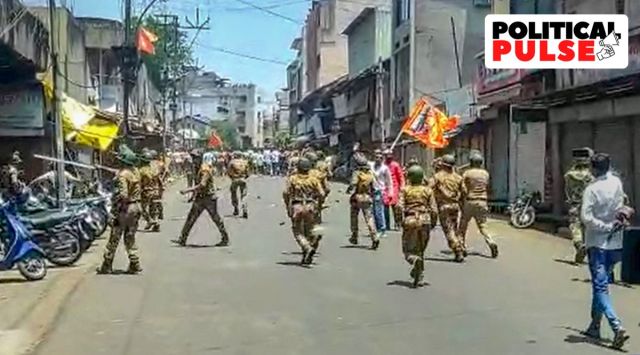How the ghost of Aurangzeb survives on the live fires of Maharashtra politics
The Mughal-Maratha conflict has long been a part of Maharashtra imagination, successfully politicised by Sena. But Aurangzeb has never been an everyday lightning rod.
 File photo of security personnel dispersing agitators objecting to the alleged use of Tipu Sultan’s image along with an objectionable audio message as social media “status” by some locals, in Kolhapur. (PTI)
File photo of security personnel dispersing agitators objecting to the alleged use of Tipu Sultan’s image along with an objectionable audio message as social media “status” by some locals, in Kolhapur. (PTI) AMID THE hardening divide over Aurangzeb in the Indian political space, the fallout is being felt most sharply in Maharashtra, where a series of recent communal events have been linked to some mention of the late Mughal Emperor.
This month has seen FIRs across the state against people – many of them young teenagers — for uploading photographs and videos of the 17th-century ruler.
While Aurangzeb ruled the Indian Subcontinent for 49 years, he spent the last 25 years of his life in areas which now constitute the state of Maharashtra, as part of his failed and expensive foray into the Deccan. The Emperor’s advance was stopped essentially by the Marathas, particularly Shivaji.
In Maharashtra’s politics, where Chhatrapati Shivaji occupies a revered space, he and Aurangzeb thus represent two extreme poles, with their conflict finding a mention in prominent writings. If social reformer Jyotiba Phule criticised Aurangzeb in his ballad written in praise of Shivaji, Hindutva hero Vinayak Damodar Savarkar referred to the Mughal as “a veritable demon in human form, (who) vowed to root out the whole Hindu world” in his book The Six Glorious Epochs of Indian History.
However, Aurangzeb still did not find much resonance in Maharashtra’s polity till right-wing organisations started painting him as the villain in their Hindu cultural renewal project. Riding that wave of religious and nativist chauvinism was the Shiv Sena.
Once its politics took an anti-Muslim turn, it started openly calling Indian Muslims descendents of Aurangzeb. In seeking to denigrate Aurangzeb, the Sena even tended to refer to him as the colloquial “Aurangya”.
The remnants of forts and monuments marking the long Maratha-Mughal rivalry which dot the state’s landscape were also used by the Sena for its political benefit.
Hence, one of the first towns identified by the Sena for a footprint outside Mumbai was Aurangabad, a city with a substantial Muslim population which was named after Aurangzeb, who is buried near the town. Bal Thackeray’s invocation of the battles between the Marathas and Mughals resulted in a communal surge that swept the Sena into power in the Aurangabad Municipal Corporation.
“For three hundred years the ghost of Aurangzeb has harassed this country….After three hundred years, history has been repeated and the ‘Mard Marathas’ have buried Aurangzeb in the same soil of Aurangabad,” Thackeray wrote in the Sena’s former weekly, Marmik, in 1988, after the Aurangabad Municipal Corporation win.
In 1995, the Shiv Sena for the first time raised the demand to rename Aurangabad as Sambhaji Nagar, with the Aurangabad Municipal Corporation helmed by it passing a resolution on the same. However, the decision could not be implemented due to legal challenges.
In recent years, with compulsions of an alliance with the Congress and NCP forcing a moderation in the Uddhav Thackeray-led Sena’s language, the BJP has emerged as the chief baiter of Aurangzeb in Maharashtra. In the wake of the recent communal incidents, senior BJP leader and Deputy Chief Minister Devendra Fadnavis, who holds the Home portfolio, said the blame for the tension lay with “Aurangzeb ki auladein (Aurangzeb’s descendants)”.
Other right-wing organisations such as the Sanatan Sanstha and followers of Sambhaji Bhide also routinely dredge up Aurangzeb in their anti-Muslim rhetoric.
This rhetoric has got sharper with Aurangabad’s renaming last year, with the minorities seeing it as another example of their marginalisation, and the Hindutva brigade pushing back.
The chain of events started with AIMIM leader Akbaruddin Owaisi’s visit to Aurangzeb’s tomb in Khuldabad in May 2022. A month later, while on its way out, the Maha Vikas Aghadi government of the Uddhav Sena, NCP and Congress announced renaming of Aurangabad as Sambhaji Nagar. A month more passed, and in July, the newly sworn in Shinde Sena-BJP government added a prefix to Aurangabad’s new name, changing it to Chhatrapati Sambhaji Nagar.
Since then, Aurangzeb routinely features in the context of communal incidents in the state, often sparked by provocative social media posts. The Shinde Sena-BJP government has claimed a deliberate ploy to create disturbance in the state, and accuses the Muslim community of glorifying the Mughal Emperor.
Many Muslim politicians are now urging the community to show their distance from Aurangzeb, calling him actually an adversary of Indian Muslims. “Aurangzeb’s legacy cannot be claimed by Hindustani Muslims. I urge the community to focus on unity and a shared vision for progress,” NCP MLA Hassan Mushrif said recently.
In private, many leaders say the feeling of rejection within the community is pushing many young Muslims to seek glory in Aurangzeb.
“Most of the guys who have done this (shared photos of Aurangzeb) are young. I believe that the discontent with what is happening in the country and the constant vilification of everything that is associated with Muslims could be a reason why we are seeing this on such a scale,” a Muslim activist who did not wish to be named said.
Sanjay Raut, the MP of Shiv Sena (UBT), which is a part of the Maha Vikas Aghadi, sees a political conspiracy behind the “revival” of Aurangzeb. “We buried Aurangzeb in the soil of Maharashtra 400 years back. He is now being revived only for the political interests of one political party,” he said.
The only politician who has openly associated with Aurangzeb amidst all this is Vanchit Bahujan Aghadi (VBA) president Prakash Ambedkar, who last week offered floral tributes at the Mughal ruler’s grave,
“What’s wrong in visiting Aurangzeb’s tomb? He was a Mughal Emperor who ruled here for 50 years. Can we wipe out history?” Ambedkar said after his visit.
On Tuesday, referring to Ambedkar’s visit, AIMIM MP Imtiaz Jaleel – the party’s only MP outside its origin state of Telangana – underlined the difference in the language of political parties after Ambedkar visited Aurangzeb’s tomb compared to when others do so.
Supporting Ambedkar’s visit to Aurangzeb’s tomb, Jaleel said when AIMIM leaders did the same, other political parties created an uproar. “It is being said now that he (Ambedkar) has the right under the Constitution (to visit a place). I want to say this too, that everyone has the right to do what they wish to, go anywhere they want to. That is the beauty of the Constitution,” the AIMIM leader said.
Asked if he supported Ambedkar’s visit to Aurangzeb’s tomb, particularly in the wake of the communal incidents, Jaleel said: “Yes, it can be supported. He wished to go there. I tell those people who are opposing the visit that this is the teaching of Chhatrapati Shivaji. People who oppose it don’t know why Chhatrapati Shivaji was great.”
Jaleel added: “Tell me one incident in 75 years when his (Aurangzeb’s) birth anniversary was celebrated or photos flashed by the Muslim community. The BJP came to power and suddenly the name ‘Aurangzeb, Aurangzeb’ comes… In 75 years, no one had an idea even how Aurangzeb looked. It is surprising that these photos (of the Emperor) have cropped up today.”
Blaming the BJP, Jaleel added: “After their defeat in Karnataka, they are trying to communalise the atmosphere. They realise that they can come to power only by creating a rift between communities… If something has gone wrong centuries back, you cannot take revenge today.”



- 01
- 02
- 03
- 04
- 05




























